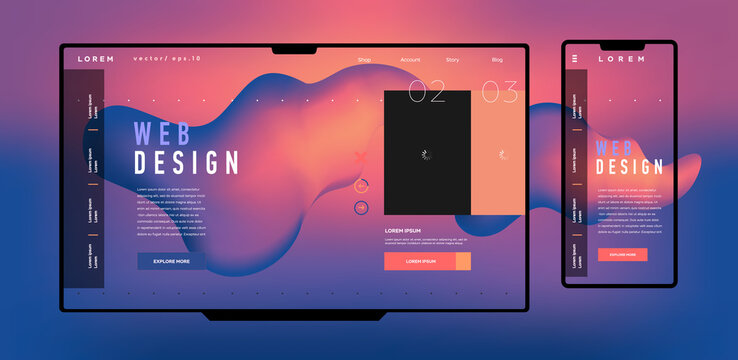High-Converting Website Design Solutions for Enhanced User Interaction
High-Converting Website Design Solutions for Enhanced User Interaction
Blog Article
Leading Tips for Creating an Impactful Site Style That Transforms
To attain this, one need to think about a variety of factors, consisting of comprehending the target audience, prioritizing user experience, and maximizing for mobile platforms. The strategic usage of compelling call-to-actions and a well-defined aesthetic pecking order plays an essential duty in assisting individuals through their trip.

Understand Your Target Audience
Understanding your target market is essential to effective internet site style, as it lays the groundwork for creating an engaging user experience. Identifying who your customers are, including their demographics, preferences, and behaviors, enables designers to tailor the internet site's web content, design, and functionality to meet specific requirements.
Carrying out detailed market research study is vital in this process. Surveys, meetings, and analytics can supply valuable understandings into individual assumptions and pain factors. By compiling this information, developers can produce customer personalities that stand for different sections of the target market, guaranteeing that layout decisions are notified and pertinent.
Additionally, recognizing the target audience assists in picking appropriate style components such as color plans, typography, and images that reverberate with users. A web site that talks straight to its audience promotes a feeling of link and trust fund, motivating longer brows through and greater conversion prices.
Eventually, a user-centered approach to website design not only improves user contentment however also sustains organization purposes by driving interaction and commitment. By prioritizing the requirements and preferences of the target market, a site can effectively serve its function and achieve desired outcomes.
Prioritize Individual Experience
To improve the general efficiency of an internet site, focusing on customer experience (UX) is essential (Website Design). A well-designed UX ensures that visitors can navigate the website easily, locate details promptly, and involve with material meaningfully. This causes raised individual contentment and greater conversion rates
Begin by executing user-friendly navigation. Menus should be logically structured, permitting customers to situate crucial areas of the site with marginal initiative. Uniformity in style elements, such as color systems and typefaces, promotes familiarity, which is crucial for maintaining customer interaction.
Additionally, consider the filling speed of your website. A hold-up of simply a few secs can cause significant drop-offs, as customers are much less likely to await a slow-loading page. Streamlining photos and enhancing code can enhance efficiency and keep site visitors.
Moreover, clearness in material presentation is crucial. Use concise, interesting language and break up text with visuals to enhance readability. By focusing on user experience, you not just develop a more pleasurable setting for visitors but likewise reinforce your brand's trustworthiness. Inevitably, a concentrate on UX is an investment in the long-lasting success of your internet site.
Maximize for Mobile Instruments
Maximizing for mobile devices is essential in today's digital landscape, where a boosting number of individuals gain access to web sites through smart devices and tablet computers. A mobile-friendly design not only boosts customer experience but also plays a substantial function in enhancing online search engine positions. To achieve this, it is important to embrace a receptive design that immediately gets used to numerous display dimensions and positionings.

Filling speed is one more critical aspect; mobile customers are usually much less client and anticipate rapid access to info. By focusing on mobile optimization, you ensure that your web site continues to be competitive and successfully involves a broader audience.
Usage Engaging Call-to-Actions
A website's efficiency usually hinges on its capability to assist site visitors towards desired actions, making compelling call-to-actions (CTAs) necessary parts of design. CTAs act as the essential factors that route customers to engage with the site, whether that implies making a purchase, enrolling in an e-newsletter, or downloading and install a source.
To produce efficient CTAs, quality is extremely important. Usage concise language that plainly interacts the action you want the user to take.
Furthermore, the design of CTAs should stand out without being interfering. Use contrasting shades and clear font styles to ensure they capture focus. In addition, think about using directional cues, such as arrowheads or pictures, to direct users towards these buttons. By focusing on these components, services can substantially enhance customer involvement, driving conversions and eventually achieving their internet site's objectives.
Concentrate On Visual Pecking Order
Reliable site design depends heavily on a well-structured visual power structure that guides customers with web content perfectly. By arranging elements in a fashion that prioritizes details, designers can boost user experience and promote decision-making. This includes making use of size, shade, contrast, and spacing tactically to accentuate one of the most critical elements of a page.
The use of bigger typefaces for headings and subheadings establishes a clear difference in between various sections, enabling customers to check content effortlessly. In addition, using contrasting colors for switches and calls-to-action can record user attention and motivate communication. Whitespace is one more crucial component; it avoids clutter and allows customers to concentrate on essential messages without diversions.
Pictures and graphics need to enhance the text while also adhering to the recognized pecking order, strengthening the general message (Website Design). Uniformity in layout components, such as color pattern and typography, more strengthens the aesthetic hierarchy, making navigation intuitive

Final Thought
In conclusion, effective site style requires a detailed understanding of the target audience, prioritization of individual experience, and mobile optimization. The tactical usage of compelling call-to-actions and a well-defined aesthetic hierarchy better enhances customer interaction. By implementing these concepts, sites can achieve higher conversion prices, making sure that style elements not just bring in visitors but additionally assist in seamless navigation and communication. Eventually, a well-executed website layout works as an important element in driving customer activities and achieving organization goals.
Report this page